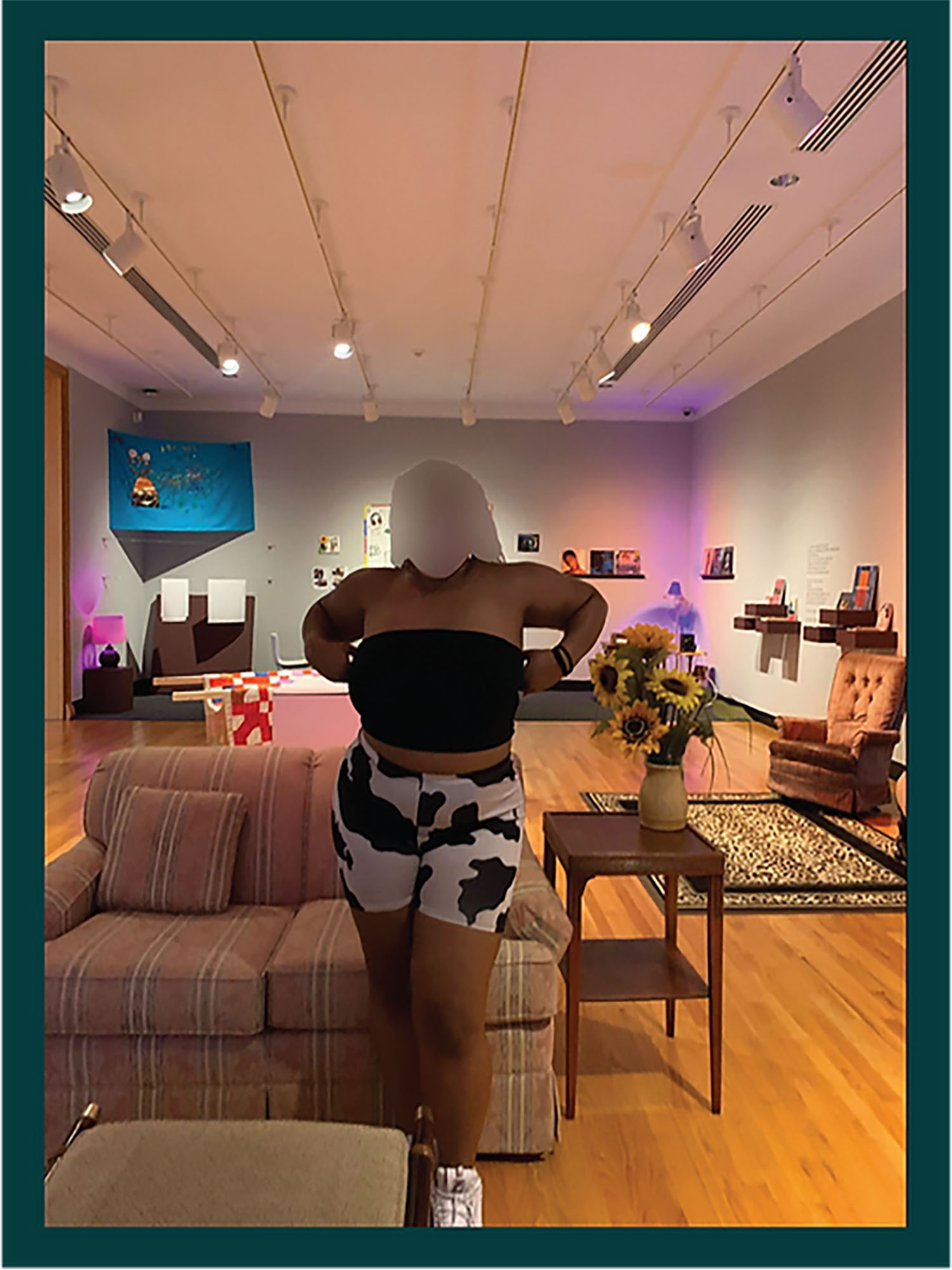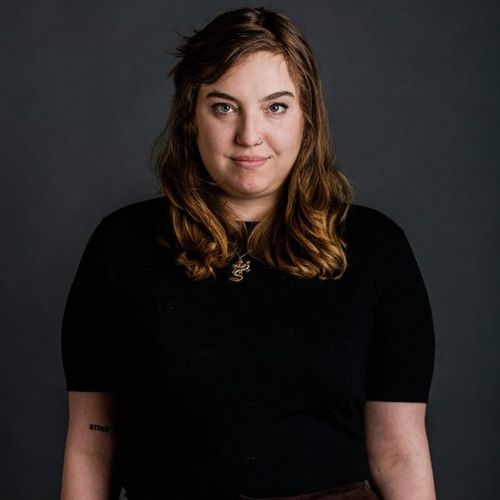New Campus Exhibition Explores What It’s Like to Be “Fat on Campus”

In Room to Live, a new photo exhibition at the Howard Thurman Center for Common Ground, a chair is not just a chair. The photos, which highlight the experiences of students in fat bodies, force viewers to rethink how students interact with physical spaces on campus.
New Campus Exhibition Explores What It’s Like to Be “Fat on Campus”
Room to Live is on view through March 1 at the Howard Thurman Center
Room to Live, the provocative new photography show at the Howard Thurman Center for Common Ground, explores what it’s like to experience life on a college campus for students who identify as fat (a conscious wording that BU Today has adopted for this story). On view through March 1, the series of iPhone photos taken by students at schools across the country shows chairs, hallways, racks of clothing at a campus bookstore, a locker room, a concrete staircase. Banal on the surface, they become symbols of discomfort, exclusion, and humiliation when the stories behind the images are revealed.
The photos and captions tell students’ intimate stories, in their own words. A chair is not just a chair, it’s an hour and a half of discomfort endured multiple times a week, while a rack of clothing that only goes up to XXL represents a lack of opportunity to wear a school logo with pride.
“I hate these desks. They’re in multiple classrooms on campus,” one caption reads. “I had been in that classroom multiple times for different classes and…the desk itself would cut into my stomach, so I couldn’t really sit there comfortably the whole hour.”

Room to Live grew out of the multiyear research project Fat On Campus, the brainchild of Terah J. Stewart, an Iowa State University assistant professor of higher education and student affairs. Stewart had assembled a team of researchers to “explore and understand the experiences of fat students on college and university campuses,” the project’s website says. It’s a “place-based study,” Stewart adds. “I was interested in physical structures; in the student affairs space, we do a lot around campus environments and how they impact learning and development.”
In 2018, the project received a grant from the Senior Scholars Group of the American College Personnel Association (ACPA). Stewart and the researchers—most had met as doctoral students at the University of Georgia—surveyed a cohort of students who identify as fat about their interactions with higher education spaces, from buildings to facilities to amenities to furniture. The responses, in the form of photos and text, became the basis for Room to Live.
Since its inception, Fat On Campus has evolved into numerous sub-elements: an online gallery, an in-person exhibition, a playlist, a syllabus, a resource page, and an ongoing call for students to share their experiences.
“Our whole team, minus our grad assistant, identifies as fat folks, and we’ve had to do our own self-work during this process,” says Roshaunda Breeden, an East Carolina University assistant professor in the department of educational leadership, and one of the Fat on Campus researchers. “This has been a five-plus-year journey with lots of buildup, lots of time to think, and lots of opportunities for us to unpack our own fatphobia and decisions we’ve made that put us where we are today.”
The mission of Fat On Campus is to challenge fatphobia, which aligns with Stewart’s primary area of academic concern: hyper-marginalized populations—those who exist “at the margins of the margins.”
Hyper-marginalization “deals with topics and experiences, like fatness, that even folks who claim to care about equity and justice don’t get,” Stewart says. “You can have someone who says, ‘I’m against inequality and oppression’—and then my question is, ‘Fat people, too?’ Sometimes the response is, ‘No, how dare you want bigger seats on an airplane?’”

In the context of hyper-marginalization, fatphobia is a problem that hides in plain sight, a notion that Room to Live’s photos and captions reinforce.
“I’ve had this happen multiple times where chairs like this have been the only seating option…” another caption reads. “And it’s like, okay, it’s kind of ironic that we’re in this training to learn how to be inclusive and accessible to people who are in the LGBTQIA+ community, and here I am, I can’t sit in this chair.”
Nick Bates, director of the Howard Thurman Center, says Fat On Campus aligns with HTC’s dedication to “see all identities included—and not just represented.” He discovered the exhibition during an ACPA conference, where it was titled #FatOnCampus: Students Navigating Place and Space in Fat Bodies and was presented in conjunction with the team’s research. Bates invited the research team to exhibit at BU under the moniker Room to Live—the first time the show has opened on a college campus.
You can have someone who says, ‘I’m against inequality and oppression—and then my question is, ‘Fat people, too?’ Sometimes the response is, ‘No, how dare you want bigger seats on an airplane?’
“In this exhibition, we speak to our space as one where everybody’s human existence is validated and nurtured,” Bates says. “To do so, we have to think about the multiplicity of identities, and [fatphobia] was an area that I felt like our university does not often discuss publicly, at least not in some of the channels and spaces that we’re used to.”
Bates partnered with other Thurman Center staff, among them Caron Camille, assistant director of programs, who was part of an HTC team that selected which photos to include in the Room to Live show.
“We wanted faculty and staff to be aware of student needs and for our students to be able to love their bodies for what they are,” Camille says.

As they went through the photos in the Fat On Campus online gallery, the team was struck by a particular student whose submissions were different from the rest: she was actually in them. Though Serena’s stories are similar to others’—she mentions feeling overlooked and wanting to hide—the photos of her, in colorful outfits and bold poses, round out the show on a more defiant and unabashedly visible note.
Fat On Campus and Room to Live are meant to both validate and challenge students: they’ll either see their own experiences reflected in the photos, or hopefully, they’ll gain a fresh perspective on an issue they may have not previously considered. It’s not just for students, though—Stewart notes that one of the main goals of the exhibition is to force school administrators to start thinking about “bodies as another dimension of diversity.”
“If we’re not doing it here, in higher education, we know it’s not happening in business. We know it’s not happening in STEM,” Breeden adds. “If we can conquer this idea of fatness being a moral issue and have some real conversations with folks, I think we really have an opportunity to change some hearts and minds.”
Room to Live, a photo exhibition that’s part of the Fat On Campus project, is on view at the Howard Thurman Center for Common Ground, 808 Commonwealth Ave., through March 1. The center is open to the BU community from 9 am to 9 pm Monday through Thursday and from 9 am to 5 pm on Friday. Admission is free.

Comments & Discussion
Boston University moderates comments to facilitate an informed, substantive, civil conversation. Abusive, profane, self-promotional, misleading, incoherent or off-topic comments will be rejected. Moderators are staffed during regular business hours (EST) and can only accept comments written in English. Statistics or facts must include a citation or a link to the citation.